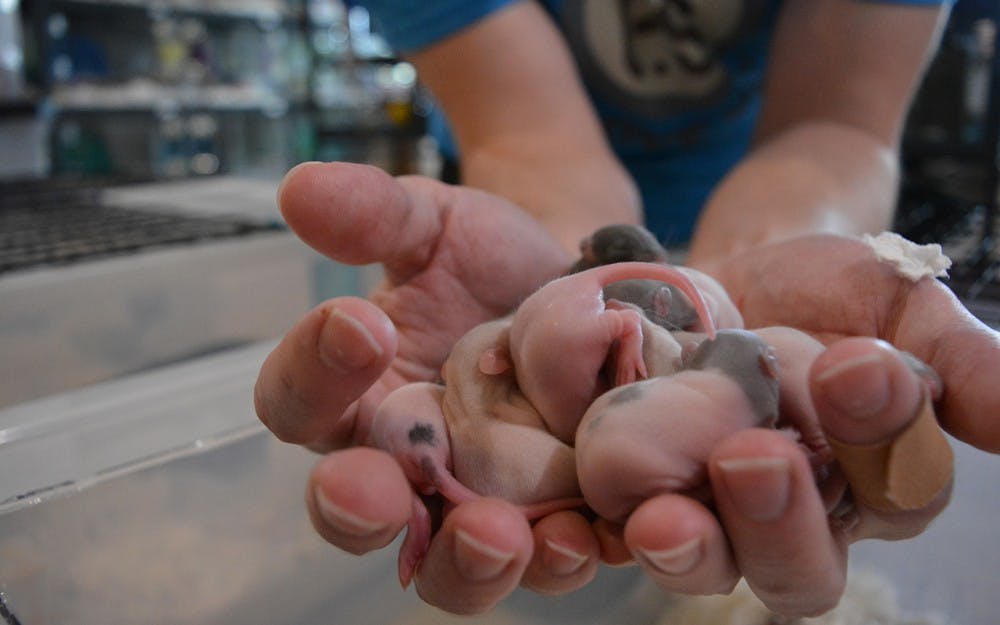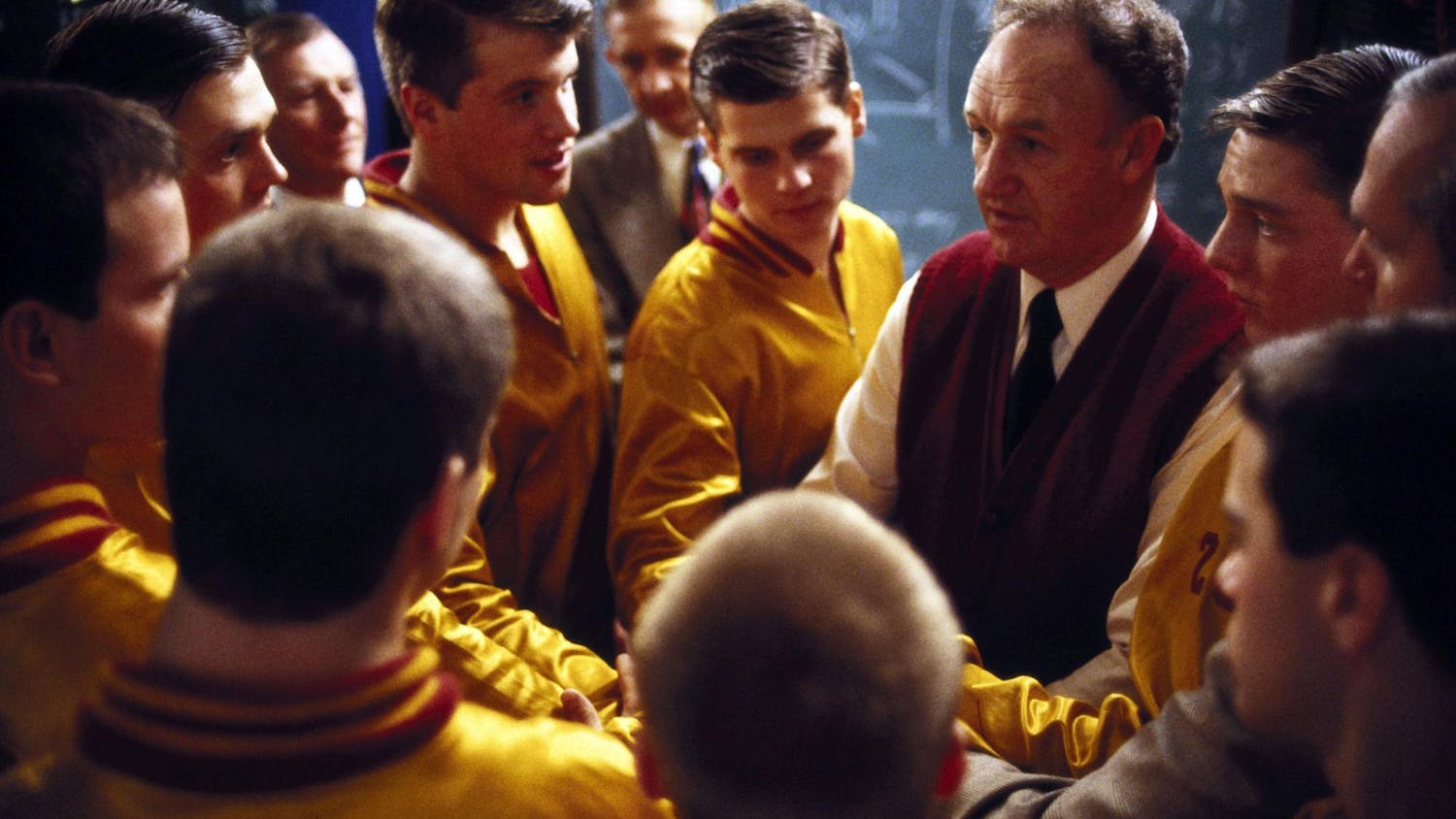Alex Hernly and Jason Minstersinly’s south side house sits in a quiet neighborhood cul-de-sac, but unlike the houses surrounding it, Hernly and Minstersinly’s home serves as an official 501c nonprofit animal sanctuary for more than 100 small rodents, including hamsters, chinchillas and rats.
“Routinely, I wonder what we have gotten ourselves into,” Hernly said.
The sanctuary — officially named the Pipsqueakery — traces its origins back to its namesake, a hamster Hernly owned named Pipsqueak. Not long after Pipsqueak died in 2012, Hernly and Minstersinly purchased three hamsters from a reptile show in an effort to save them from being reptile food. The rescue mission continued from there.
In March 2013, the two officially gave the the Pipsqueakery its name and the intake of rodents increased. Hernly and Minstersinly were both still in school. Hernly was at Maurer School of Law and Minstersinly was finishing a nursing degree , which Minstersinly said made running the sanctuary challenging but rewarding.
“Every day was a tough struggle, and it really helped us to have our hamsters and give them a life of luxury," Minstersinly said. "It doesn’t take much to get them the best food, the best houses.”
In the beginning, the few hamsters they had lived with them in their small apartment. When Hernly graduated law school, the two immediately began searching for a house so both them and the rodents could live more comfortably together.
“I told the realtor all I really wanted was a good basement for our rodents,” Hernly said. “This was the second house we looked at, and we were like, ‘this is it.’”
The basement is large with a small kitchenette that includes a sink Minstersinly said makes it easy to wash the rodents’ tiny dishes. An adjacent room has medical-grade equipment and serves as a hospital room for sick rodents. Because Minstersinly has a degree in nursing and the couple counts numerous vet technicians as friends, they are often able to help the animals in need on their own.
Hernly and Minstersinly’s medical savviness saved Spooky the rat. Spooky suffered from congestive heart failure, and it’s likely that in any other situation, she would have died or been euthanized. However, Hernly and Minstersinly were able to hook up oxygen to her cage in such a way that she not only gets the extra oxygen she needs but is able to scamper around and socialize, which they said is essential for rats.
“This way she gets to live a fairly normal life and she gets to run around with her friends,” Minstersinly said.
Hernly said stories like Spooky’s are the most rewarding part of the sanctuary for her. When things get difficult, she said she thinks about stories like Spooky’s and of Mortimer, a fluffy, white, formerly undernourished special-needs guinea pig that Hernly said tripled in size after she and Jason rescued him.
“I never planned to do this at all,” Hernly said. “But we got three hamsters, and then we got three more, and then we got three more.”
Now, their basement is stacked with cages and cages of rodents they’ve rescued since. Strips of tape mark each of them with the corresponding animal’s name — names like Coraline Mae, Mary Tyler S’Moore, and Flub and Blooper for two hamsters born unexpectedly. Hernly said it never becomes difficult to find new names for the animals and that the two have a list of names they’re hoping to use in the future.
“Alex texted me when I was at work [one time] and said, ‘we really need a whole bunch of names,’” Minstersinly said. “So I walked over to the newly opened geriatric unit at the hospital I was working at and I wrote down the first names on the board.”
Because they rescued so many rodents, the couple realized the sanctuary was a full-time commitment. Minstersinly quit his nursing job to tend to the rodents while Hernly works as lawyer during the day.
“On a typical day, Alex will wake me up before she goes to work, and I’ll come downstairs and start doing the rounds,” Minstersinly said.
He’ll start on the floor with the diabetic rats and give them their first round of insulin for the day. Then he’ll carefully measure water into their bottles and monitor how much they drink so he can gauge how their diabetes is doing. All the rodents receive their first meal in the morning and sometimes eat specially prepared food that Minstersinly makes for them. Mortimer, the once-sickly guinea pig, eats a powdered food that Minstersinly flavors with canned pumpkin so that it tastes better.
Some rodents receive what amounts to hospice care, where Minstersinly and Hernly attempt to make their final days more pleasant by feeding them their favorite foods, such as blueberry muffins, and keeping them comfortable. Because hamsters only live an average of 1-3 years, Hernly said they see a lot of death at the sanctuary.
“We’ve had 105 deaths total in the time we’ve been doing this,” Hernly said. “It’s hard.”
Minstersinly said that the two joke with each other about it sometimes to ease the difficulty.
“We’ve jokingly called ourselves the hamster Grim Reapers or the hamster death counselors before,” Minstersinly said.
To commemorate the lost hamsters, Minstersinly and Hernly have hung headshots of them along the staircase leading down to the sanctuary. Pipsqueak is one of the last photos photos before the full descent into the basement.
Emotional challenges aren’t the only ones the couple face regularly. Financially, the sanctuary costs them a significant amount of money per month. For the hamsters, the bare minimum supplies of food, water and bedding costs about $600 per month, Hernly said. Vet care costs another $600 per month for all the rodents. If all of the costs were added together, including things electricity and time, Hernly said they spend more than $100,00 per year.
While Minstersinly works with animals during the day, Hernly uses break times at work to fundraise and post to social media. The Pipsqueaker’s Instagram account has nearly 70,000 followers, making the social media work its own full time job, Hernly said.
Because their online presence draws people with questions about their own pets, Hernly and Minstersinly often answer questions people have.
“It’s sort of part of our role as hamster educators,” Minstersinly said.
For now, the two have their hands full and don’t anticipate a large expansion anytime soon. At night, Hernly said she and Minstersinly spend most of their evenings taking care of the rodents. Hernly said they would like to continue to focus on animal sanctuary and giving special needs rodents the comfort and attention they wouldn’t be able to receive else where.
“We get a chance to take these animals who wouldn’t have a shot at life and watch them thrive,” Hernly said. “It’s very rewarding.”






